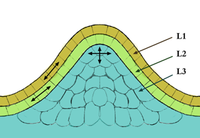
Optimized Whole-Mount In Situ Immunolocalization for Arabidopsis thaliana Root Meristems and Lateral Root Primordia.
Sign Up to like & getrecommendations! Published in 2018 at "Methods in molecular biology"
DOI: 10.1007/978-1-4939-7747-5_10
Abstract: Immunolocalization is a valuable tool for cell biology research that allows to rapidly determine the localization and expression levels of endogenous proteins. In plants, whole-mount in situ immunolocalization remains a challenging method, especially in tissues… read more here.
Keywords: root; immunolocalization; biology; lateral root ... See more keywords

Long-distance regulation of shoot gravitropism by Cyclophilin 1 in tomato (Solanum lycopersicum) plants.
Sign Up to like & getrecommendations! Published in 2020 at "Planta"
DOI: 10.1007/s00425-020-03448-5
Abstract: MAIN CONCLUSION The phloem-mobile protein SlCyp1 traffics to distant parts of the shoot to regulate its gravitropic response. In addition, SlCyp1 targets specific cells in the root to promote lateral root development. The tomato (Solanum… read more here.
Keywords: cyclophilin; lateral root; shoot gravitropism; slcyp1 ... See more keywords

Quantitative trait loci (QTLs) linked with root growth in lettuce (Lactuca sativa) seedlings
Sign Up to like & getrecommendations! Published in 2019 at "Molecular Breeding"
DOI: 10.1007/s11032-019-1089-x
Abstract: In-field variation of transplanted lettuce (Lactuca sativa L.) due to variable soil and environmental conditions is one of the major restrictions in the optimization of production and yield. Marker-assisted breeding for lettuce varieties with a… read more here.
Keywords: variation; root; root growth; qtls ... See more keywords

The Xerobranching Response Represses Lateral Root Formation When Roots Are Not in Contact with Water
Sign Up to like & getrecommendations! Published in 2018 at "Current Biology"
DOI: 10.1016/j.cub.2018.07.074
Abstract: Efficient soil exploration by roots represents an important target for crop improvement and food security [1, 2]. Lateral root (LR) formation is a key trait for optimizing soil foraging for crucial resources such as water… read more here.
Keywords: response; water; formation; root formation ... See more keywords

Unraveling a Local Inhibitory Mechanism Safeguarding Regular Lateral Root Spacing.
Sign Up to like & getrecommendations! Published in 2019 at "Developmental cell"
DOI: 10.1016/j.devcel.2018.12.010
Abstract: The mechanisms underlying even spacing of lateral roots remains incompletely understood. In this issue of Developmental Cell, Toyokura et al. make an important step forward by showing how a local inhibitory mechanism involving a novel peptide… read more here.
Keywords: root spacing; inhibitory mechanism; local inhibitory; mechanism ... See more keywords

A Co-opted Regulator of Lateral Root Development Controls Nodule Organogenesis in Lotus.
Sign Up to like & getrecommendations! Published in 2020 at "Developmental cell"
DOI: 10.1016/j.devcel.2019.12.009
Abstract: Legumes, a subset of flowering plants, form root nodules in symbiosis with nitrogen-fixing bacteria. The regulatory network controlling nodule formation has remained mysterious. In a recent issue of Science, Soyano et al. (2019) demonstrate that co-option… read more here.
Keywords: lotus; nodule organogenesis; root; opted regulator ... See more keywords

Up-regulation of CmNRTs and CmANR1 genes expression contribute to root configuration changes for efficient capturing NO3− in the roots of chrysanthemum
Sign Up to like & getrecommendations! Published in 2017 at "Scientia Horticulturae"
DOI: 10.1016/j.scienta.2017.06.014
Abstract: Abstract Nitrogen is very important to the yield and quality of chrysanthemum. However, excessive application not only negatively affects the yield and quality of chrysanthemum, but also can not be timely absorbed and utilized for… read more here.
Keywords: cmnrts cmanr1; regulation cmnrts; root; cmanr1 genes ... See more keywords

MAPK Signaling: Emerging Roles in Lateral Root Formation.
Sign Up to like & getrecommendations! Published in 2019 at "Trends in plant science"
DOI: 10.1016/j.tplants.2019.11.006
Abstract: Lateral root (LR) formation is a multistep developmental process in which auxin and peptide hormones play essential roles. Recent studies in arabidopsis by Huang et al. and Zhu et al. have revealed that the mitogen-activated protein kinase… read more here.
Keywords: root formation; lateral root; mapk signaling;

Heterogeneous phosphate supply influences maize lateral root proliferation by regulating auxin redistribution.
Sign Up to like & getrecommendations! Published in 2019 at "Annals of botany"
DOI: 10.1093/aob/mcz154
Abstract: BACKGROUND AND AIMS Roots take up phosphorus (P) as inorganic phosphate (Pi). Enhanced root proliferation in Pi-rich patches enables plants to capture the unevenly distributed Pi, but the underlying control of root proliferation remains largely… read more here.
Keywords: supply; heterogeneous supply; root proliferation; root ... See more keywords

Theanine, a tea-plant-specific non-proteinogenic amino acid, is involved in the regulation of lateral root development in response to nitrogen status
Sign Up to like & getrecommendations! Published in 2022 at "Horticulture Research"
DOI: 10.1093/hr/uhac267
Abstract: Abstract Glutamine synthetase type I (GSI)-like proteins are proposed to mediate nitrogen signaling and developmental fate by synthesizing yet unidentified metabolites. Theanine, the most abundant non-proteinogenic amino acid in tea plants, is the first identified… read more here.
Keywords: theanine; development; tea; lateral root ... See more keywords

Serratia marcescens PLR enhances lateral root formation through supplying PLR-derived auxin and enhancing auxin biosynthesis in Arabidopsis.
Sign Up to like & getrecommendations! Published in 2022 at "Journal of experimental botany"
DOI: 10.1093/jxb/erac074
Abstract: Plant-growth-promoting rhizobacteria (PGPR) refer to bacteria that colonize the rhizosphere and contribute to plant growth or stress tolerance. To further understand the molecular mechanism of symbiosis of plants-PGPRs, we performed a high-throughput single colony screening… read more here.
Keywords: root; root formation; plr; lateral root ... See more keywords